Beyond Mozie-ing Around: a Californian Dutch Bike Visits Ireland
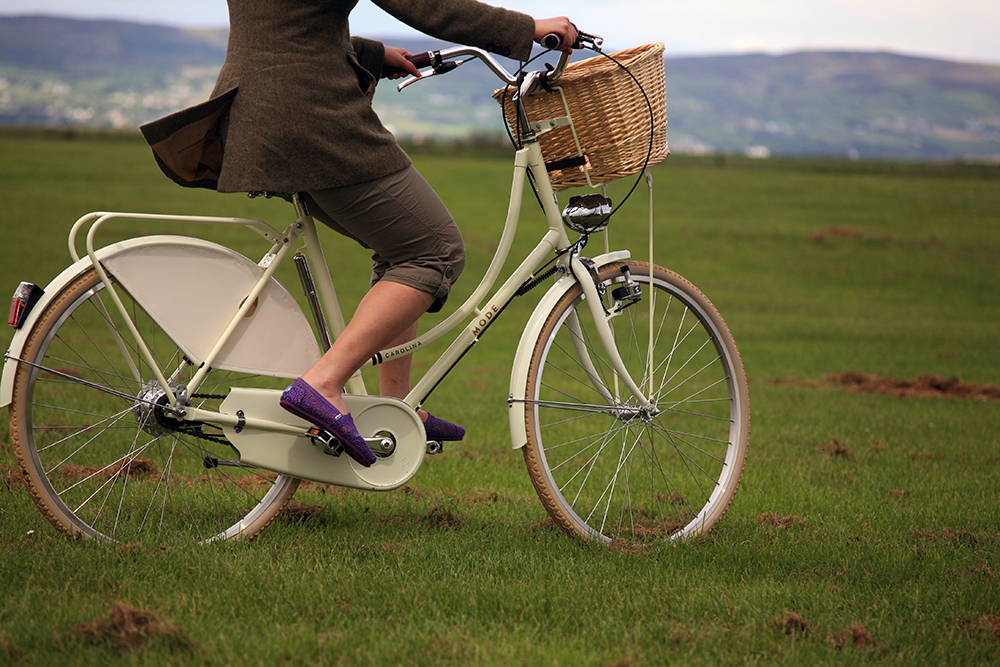
At the time of writing this review, I do not think it unfair to say that the Dutch bike craze in North America has come and gone. When the bicycles first appeared on the scene around 2008, they were a source of fascination. The concept of the Dutch bike inspired us with images of carefree, relaxed, un-athletic cycling - of bicycles that allowed the rider to sit bolt-upright, "as if in a chair," while effortlessly floating along, groceries or toddlers casually in tow. With these machines came the promise of a dignified, utilitarian and (dare I say it?) fashionable means for ordinary people to ride a bicycle for transportation without changing the way they dressed.
But as nice as it all sounded in theory, in practice it didn't stick. Routinely, those North Americans who had purchased Dutch bikes discovered that conditions where they lived were too hilly to make these lovely machines practical. Or too windy. Or the distances were too long. Or the car traffic called for more nimble and aggressive handling. So they made adjustments to their Dutch bikes, attempting to lighten them, and to install lower gearing, and to lower the handlebars, before - more often than not - ultimately switching to a different style of bicycle. As the transportation cycling culture in the US grew, a preference emerged for machines that - while still relatively upright and fitted with utilitarian accessories - were of a lighter, sportier, more compact nature than the prototypical Dutch bike.
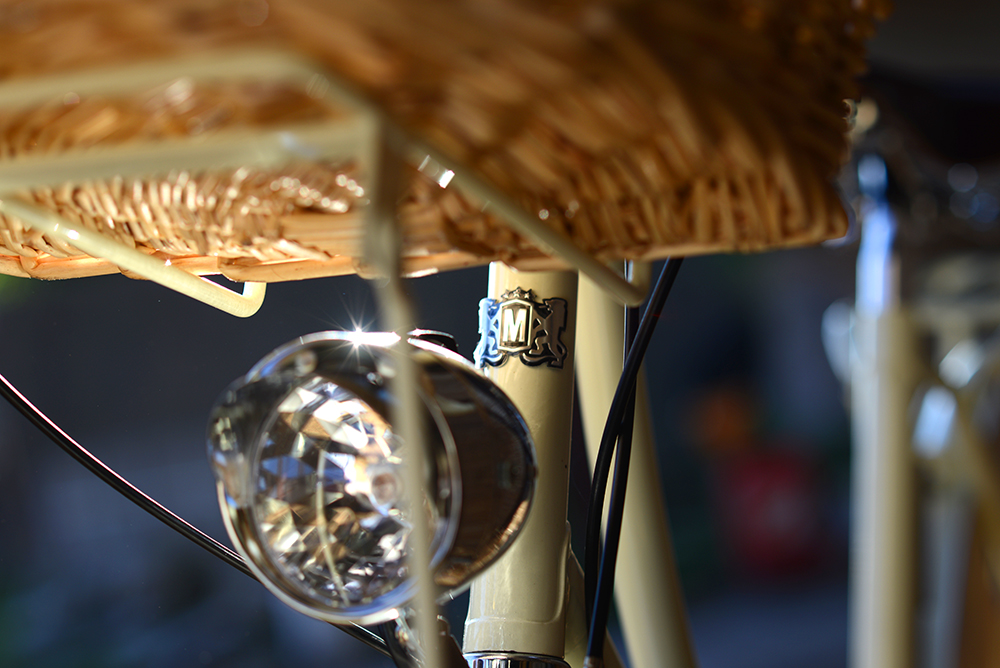
Which is all well and good and fascinating to observe. But which also made it surprising, I thought, that a company in California was now launching a new, Dutch-style line of bicycles and was offering me to test one for a long-term review. And this, despite my having moved to rural Ireland - where conditions were even hillier, windier, longer-distancier, and altogether less welcoming for a bike of this sort. I pointed all of this out to the nice Californian company. But they were keen to subject their bike to my testing anyhow. And so, all through the summer of 2014 I cruised the hilly, draggy country roads of the Roe Valley on a Mozie Carolina bicycle.
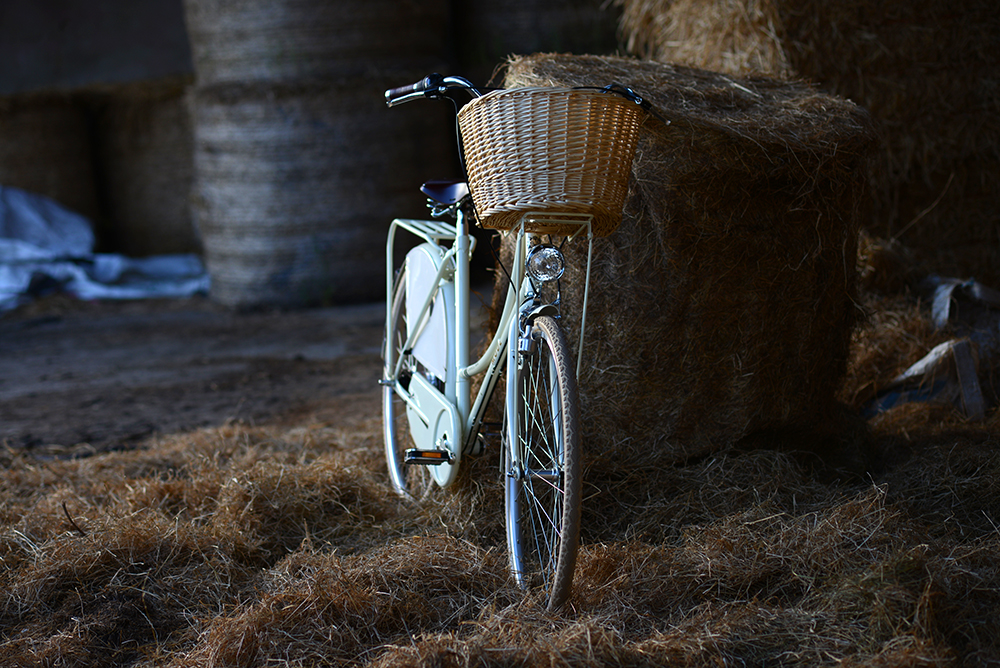
Described as having been "inspired by the rich bicycle culture of regions such as Holland and Denmark," the Mozie does indeed resemble the bicycles one is likely to see on the streets of Amsterdam and Copenhagen.
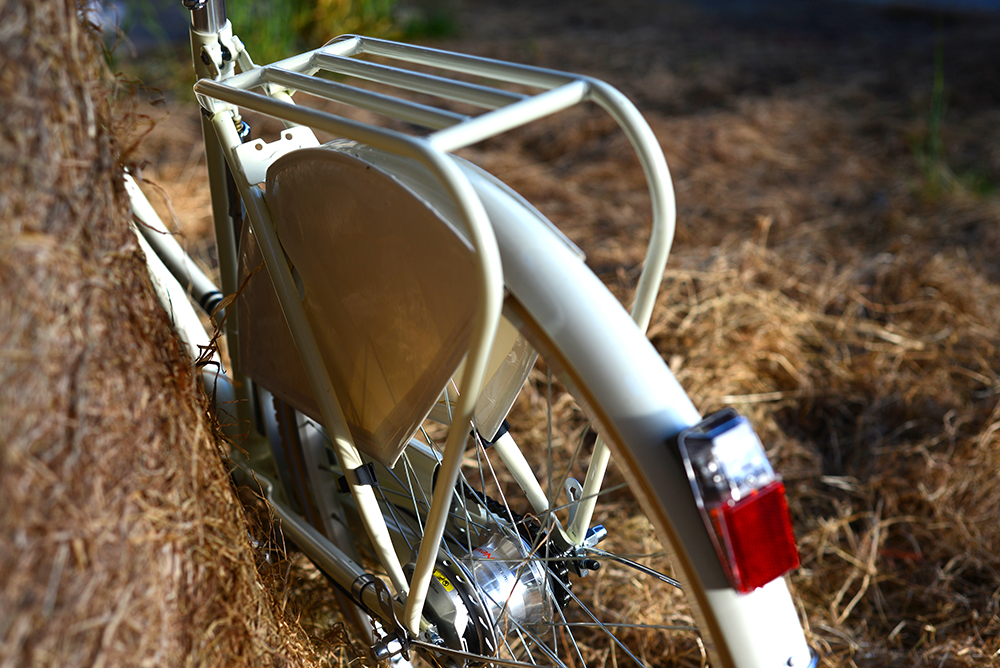
From the deeply curving loop frame and the swept-back handlebars, to the hefty rear rack, fenders, dress-guards,
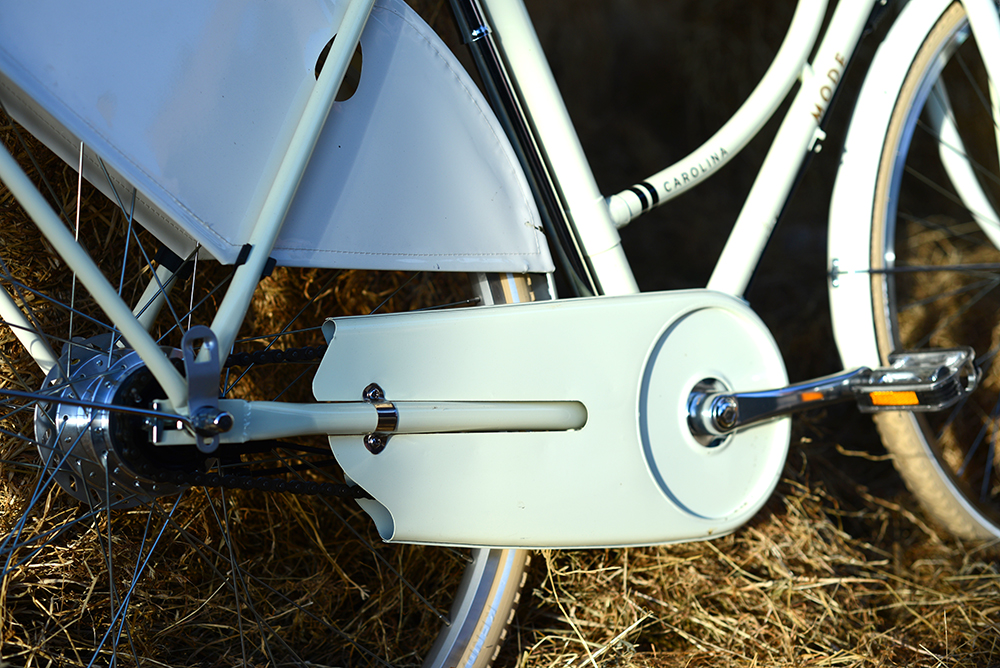
chaincase, hub gears,
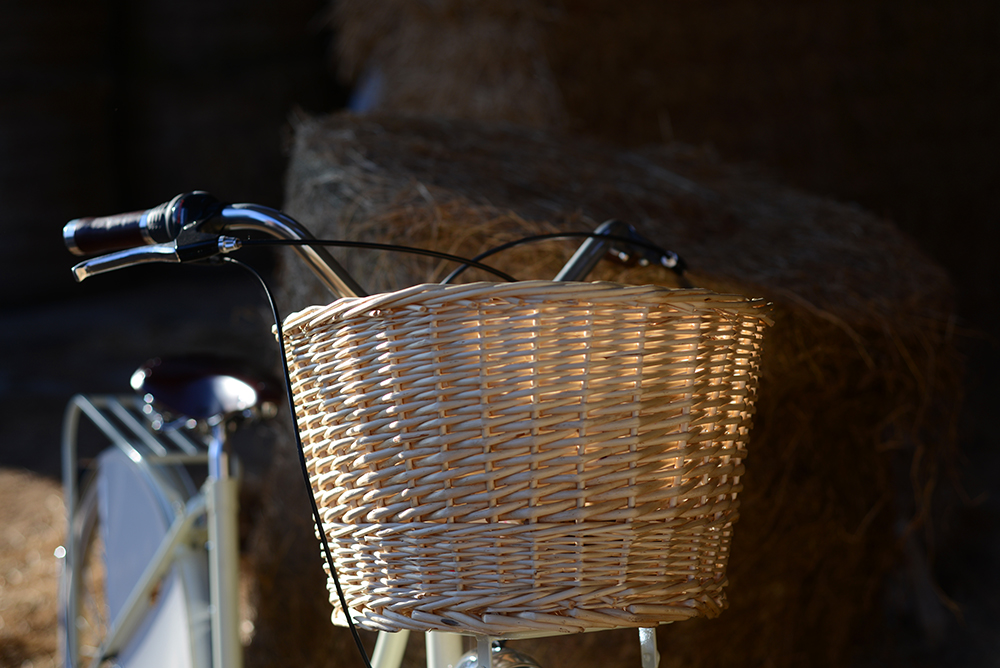
wicker basket,
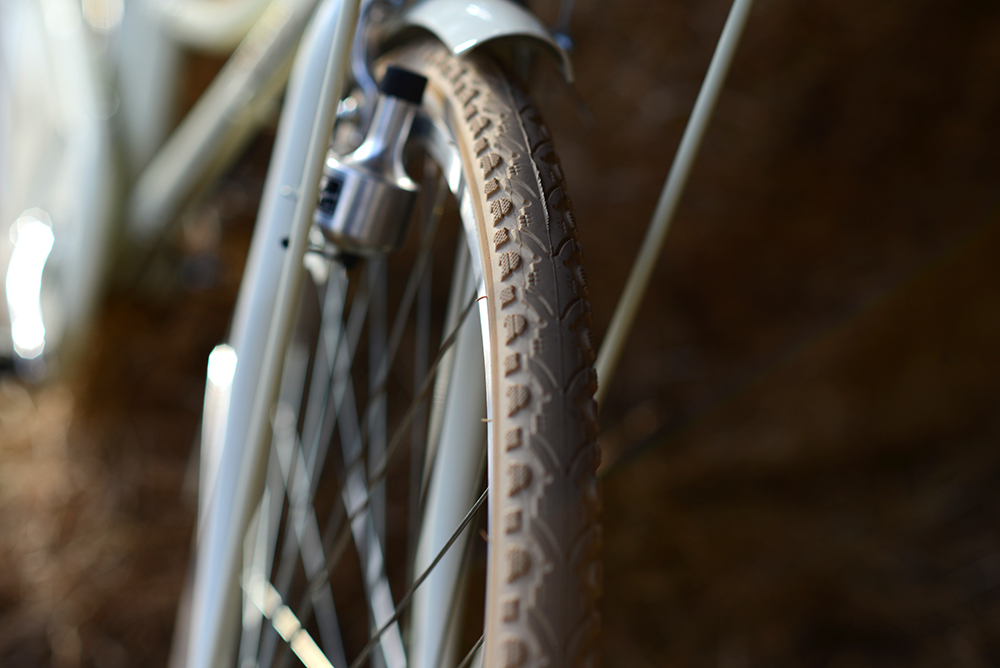
big fat tires,
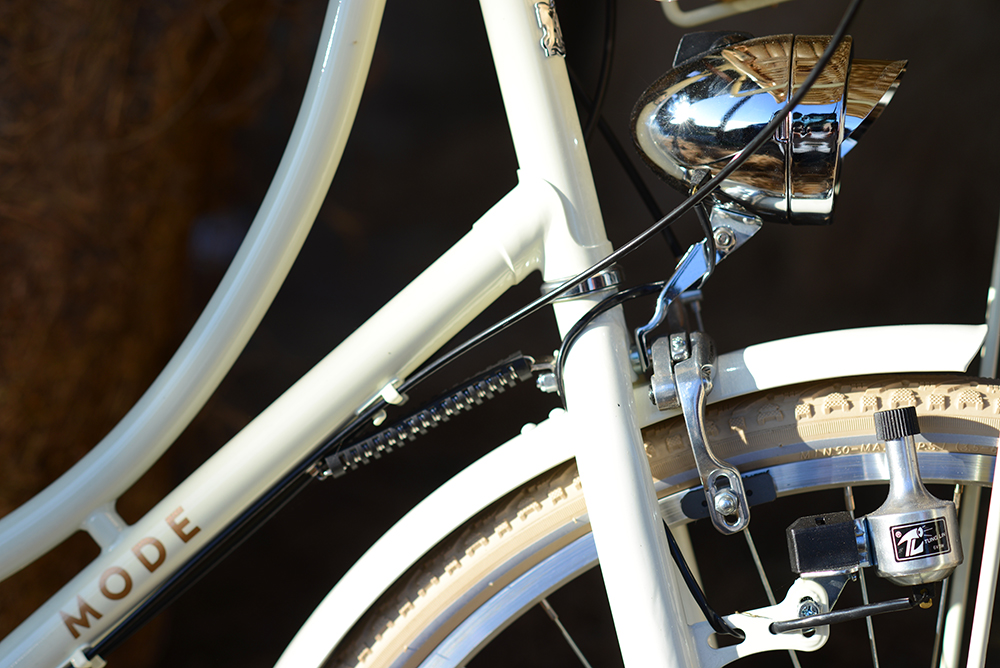
and even bottle dynamo-driven lighting.
With its lugged cream frame and cream tires, the Carolina is a very pretty bicycle. ("And very Californian looking!" in the opinion of a few Irish friends.)
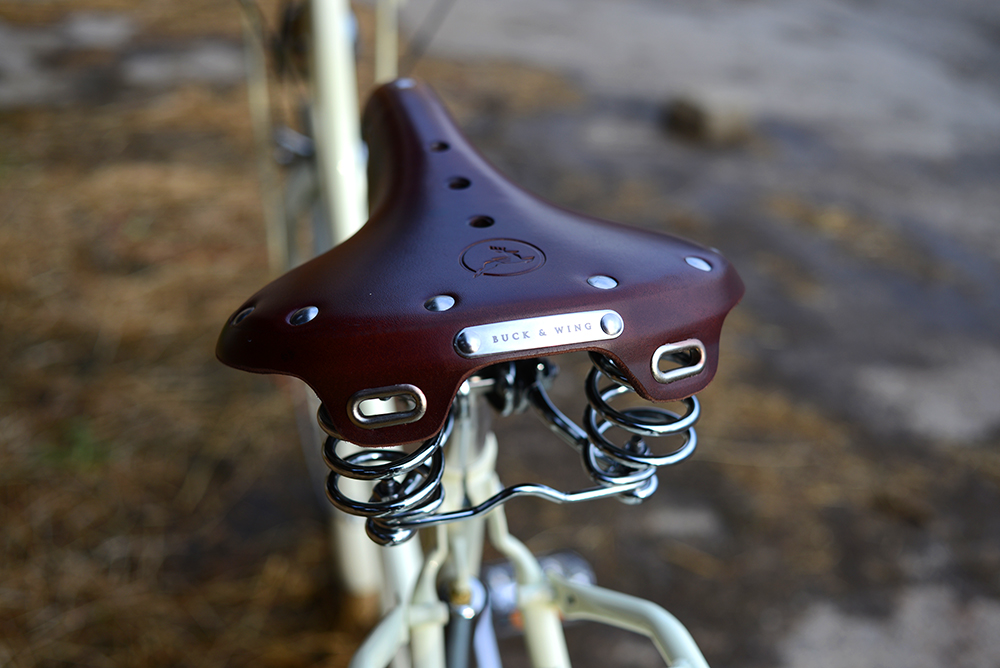
This is nicely complemented by a reddish-brown leather saddle and matching grips. Labeled Buck & Wing, these appear to be an in-house brand of Mozie.
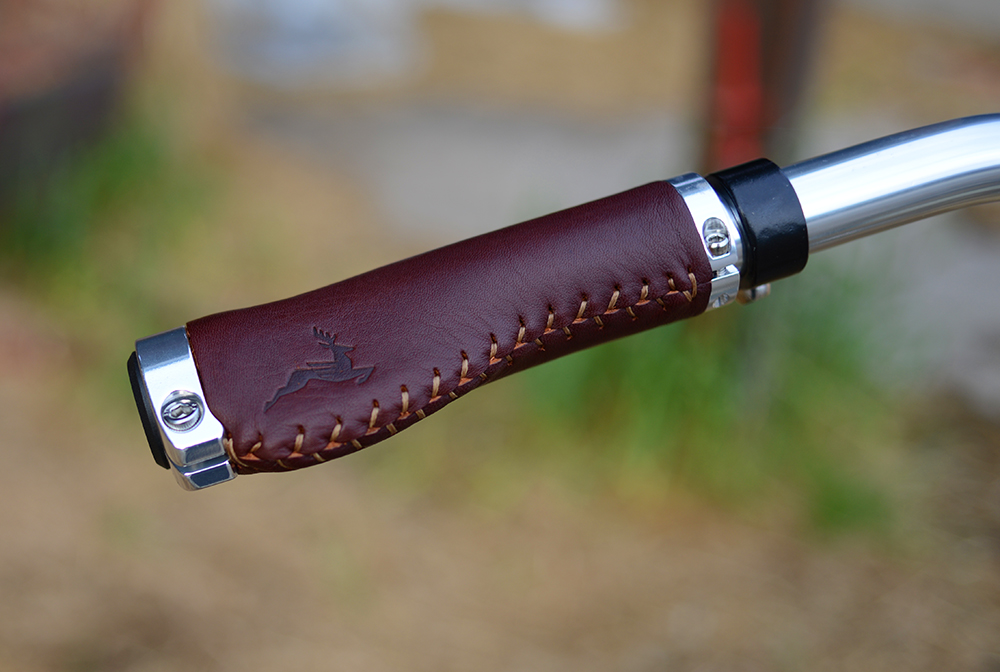
While the ergo-style shape of the grips is not really my thing, I do like the saddle - which is just the right width and firmness for the Carolina.
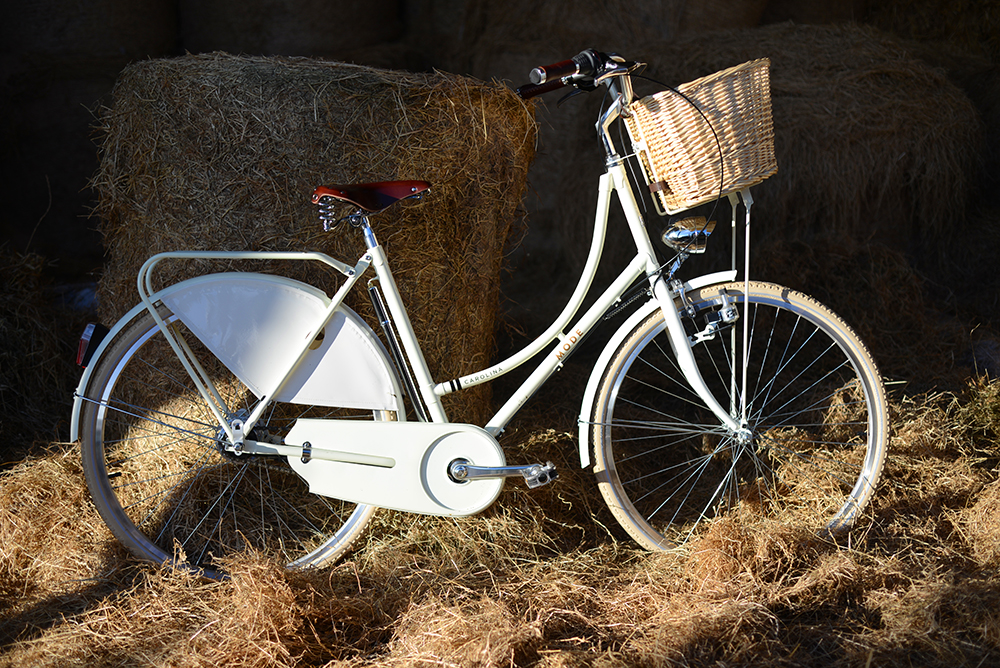
The Carolina's proportions resemble those of many Dutch and Danish bikes I have seen. Though in photos this bicycle has a diminutive look to it, it is actually quite large - with a 54cm x 57cm frame hoisted up on 700C wheels with 38mm tires. As you can tell by the saddle's position, I am at the shorter end of the spectrum as far as fitting this bike - and I am just under 5'7".
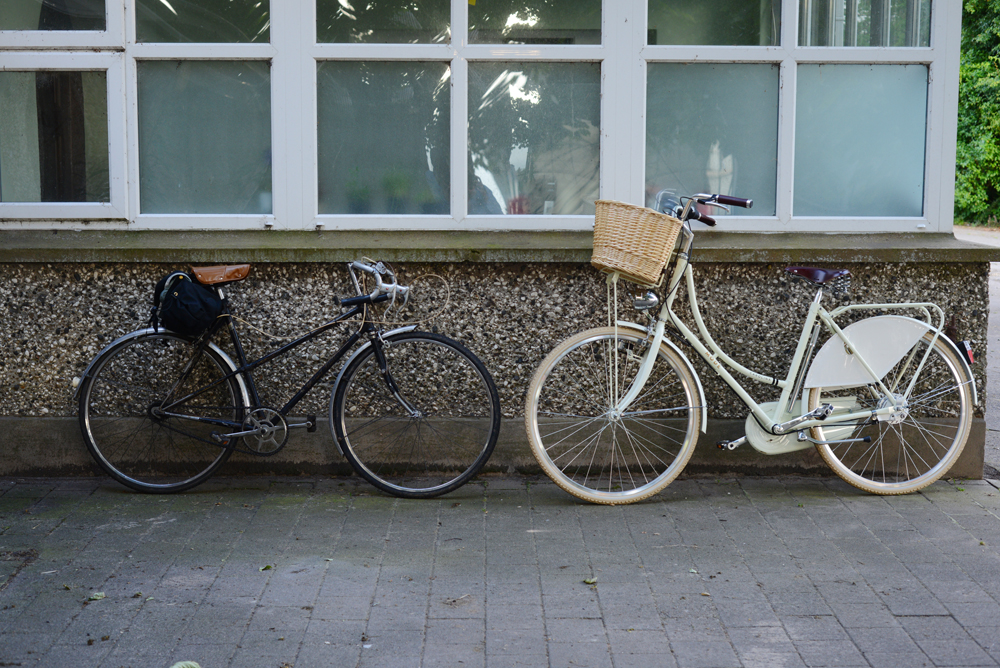
Having my saddle set so low meant that even with the handlebars in their lowest possible position (considering that room had to be allowed for the basket), proportionally they would still sit extremely high for me, which made me a bit apprehensive. Even on the genuinely Dutch Gazelle I once owned, I had eventually pushed the bars down a tad to give myself some lean. Because, to be honest, even for flat, urban riding, the bolt-upright position had never been quite to my taste. On a bicycle, "sitting as if in a chair" just never felt as nice as it sounded.
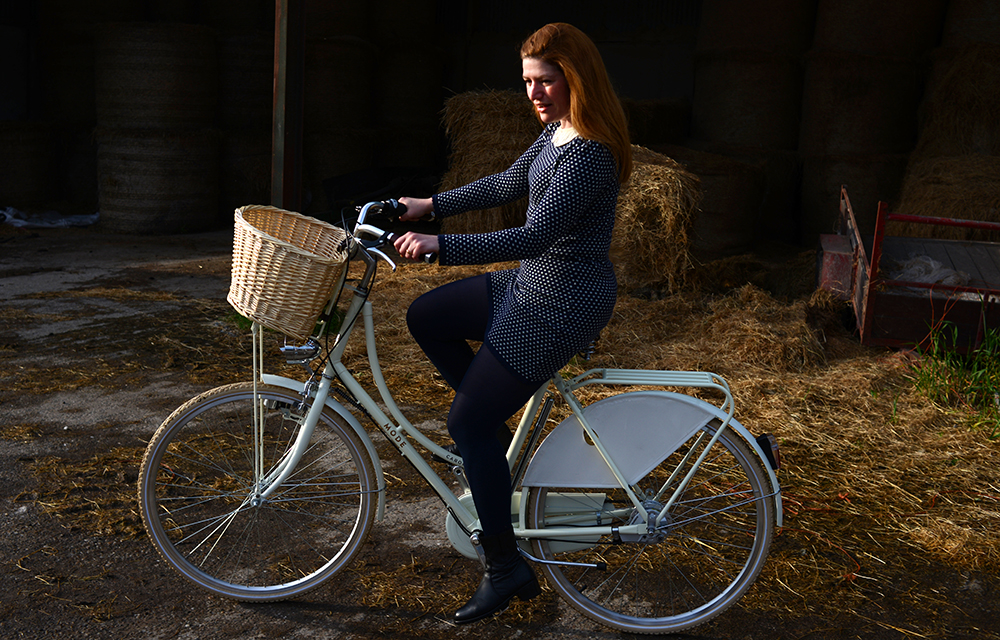
Until now that is. Though I am always weary of over-praising bicycles I have been given to review, I have to say the Mozie is amazing if only for the simple fact it feels "right" ridden in the bolt-upright position it was intended for. What I mean is, that I have ridden other bicycles designed to be set up in this manner, but always felt compelled to lower the handlebars. The Mozie is the first Dutch-style bicycle I've tried where the "sitting as if in a chair" thing actually worked for me.
Not only does the position in itself feel comfortable, but the bicycle is surprisingly maneuverable - accelerating quickly and moving nimbly through tight and tricky spaces - all while sitting back and relaxing in the saddle. In case I were imagining how great the handling was, I asked an experienced roadie friend to try it, as well as his equally sporty daughter - saying nothing to them about my own impressions. Both immediately began to perform tricks on the bike, marveling at how responsive the handling was compared to other "tanks" they've tried. Then the farmer next door had a go, and immediately began to ride the Mozie backwards. It's the kind of bike that makes you want to do that sort of thing. Despite its 48lb weight, the Mozie is far from sluggish or heavy-going.
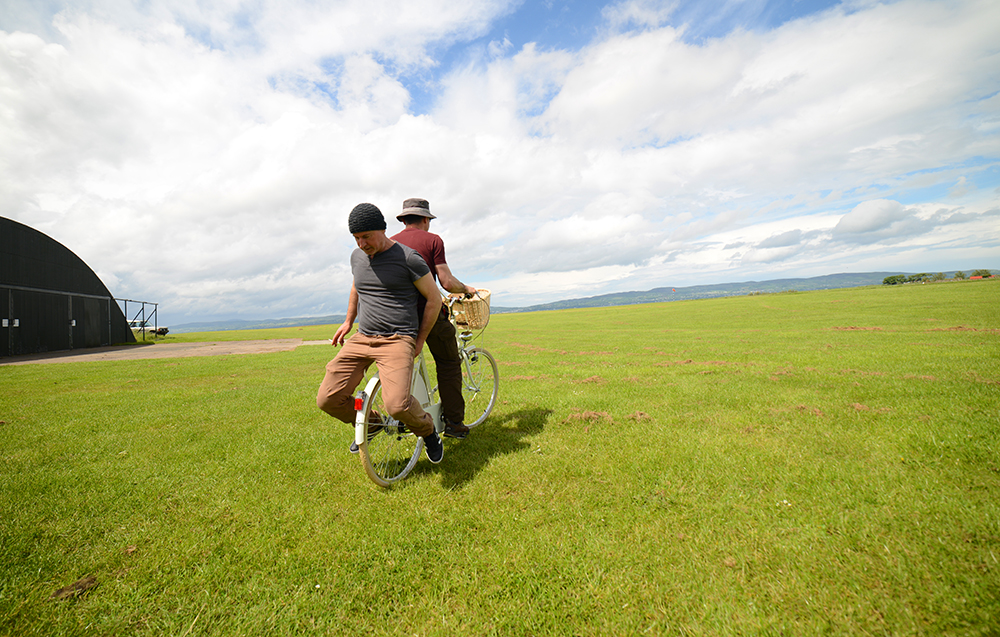
Having arrived on the Mozie to the nearby airfield one day, it proved a great hit with the pilots as well. The boys began racing it along the airfield, impressed at how quickly it rolled along the soft, post-rain soil and thick grass... even when carting each other around on the rear rack. For reference, the man in the photo weighs 185lb - in his own words, a "big, heavy lump." The rack did't even flinch.
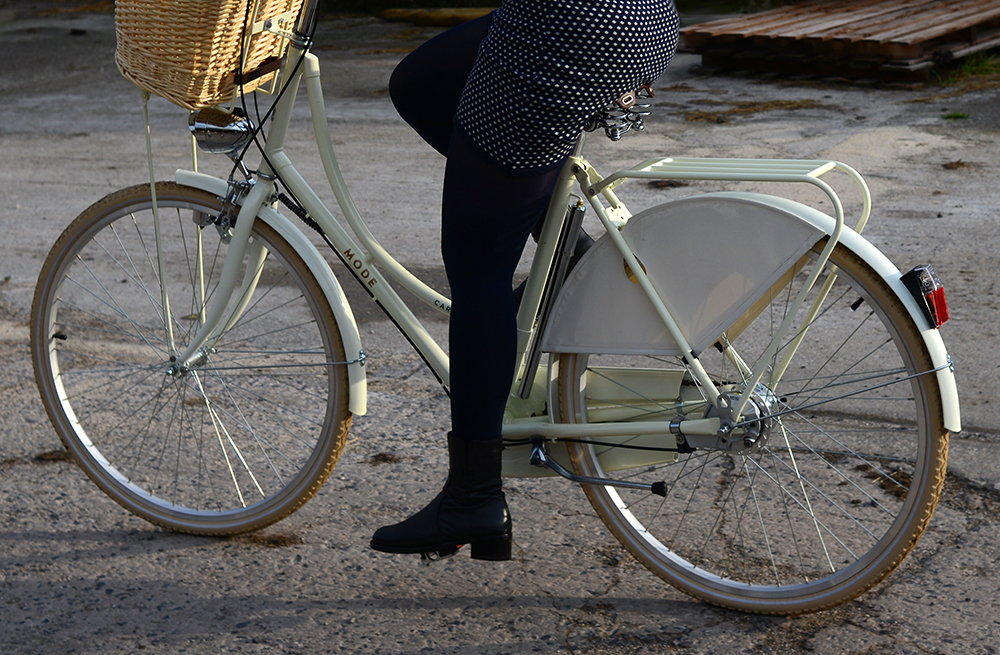
Aside from the handling, what I love about this bike is the low bottom bracket, allowing for perfect leg extension in motion,
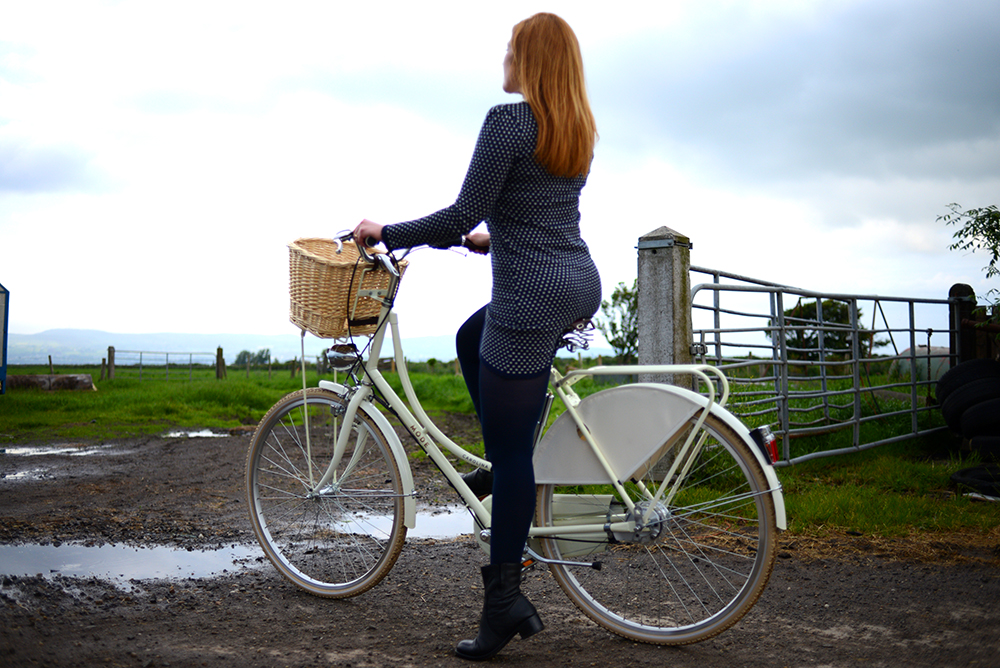
as well as for putting a foot down when stopped. Furthermore, there is no toe overlap. And the ride quality over bad roads is as cushy as one would expect from a Dutch-style machine. There may be no cobblestones on the farm lanes, but there are pot holes and washboard stretches aplenty.
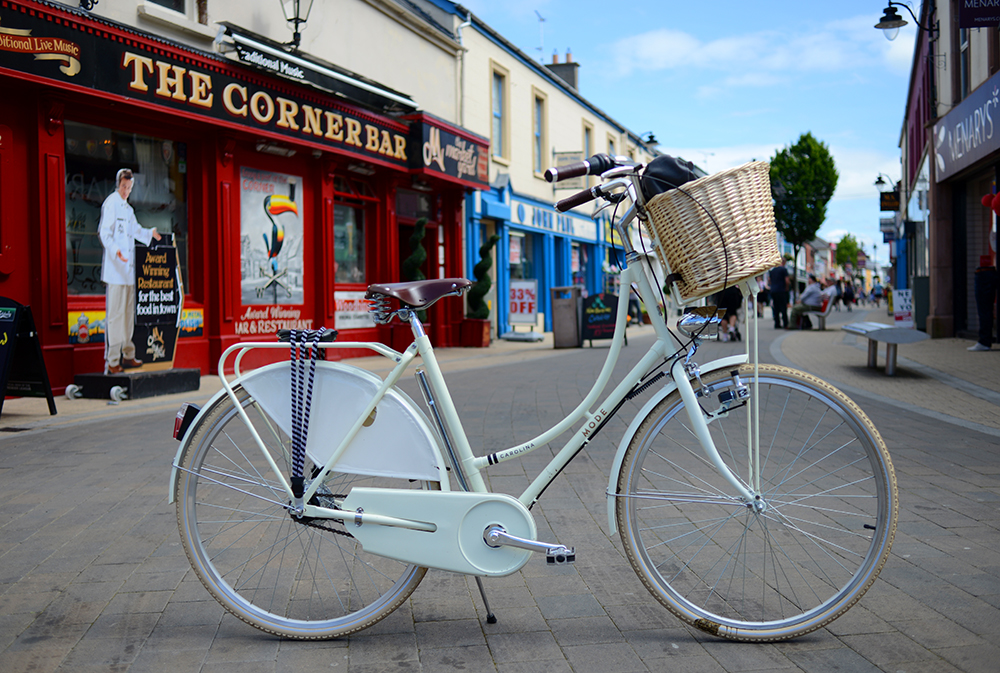
In the course of the testing period, I routinely used the Mozie for up to 10 mile trips into the nearby towns. Although these routes are "easy" by local standards, they are nonetheless not what you might call Dutch bike-friendly - featuring some rolling hills, as well as a couple of decent climbs. Despite its weight and upright positioning, the Mozie handled the rollers excellently, retaining its downhill momentum well enough to coast up a good part of the next climb. Even prolonged hills were tolerable - so much so that I did not really need the two lowest gears of the Shimano 7-speed hub. Though the bike was slower than the machines I typically ride here, it did deliver me into the town without much hassle, in a relaxed and civilised manner.
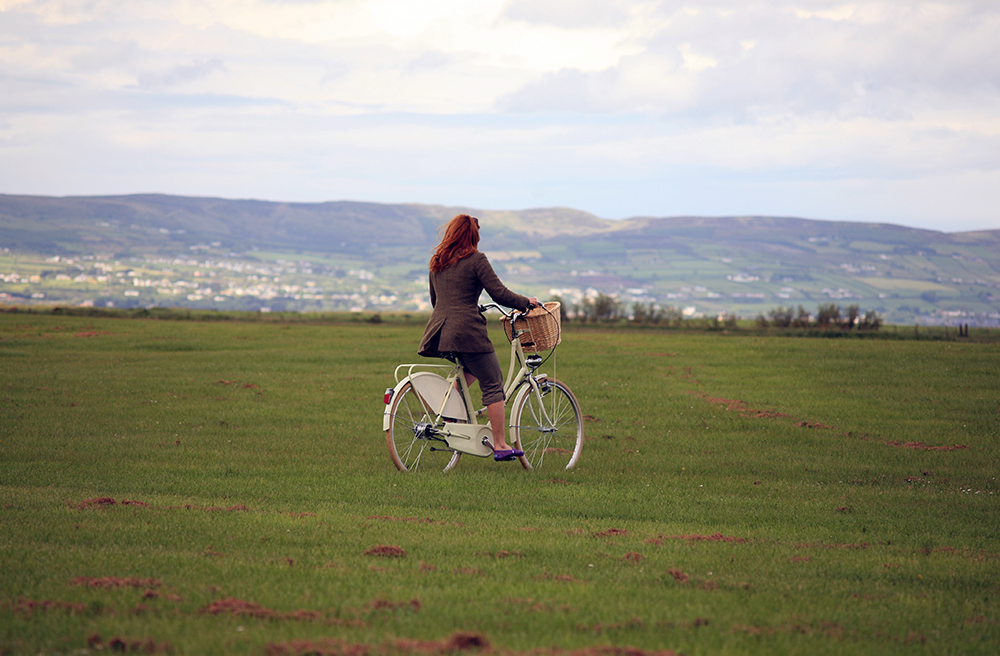
As far as the rural Irish landscape, the Mozie's only weakness really is the wind. On a windy day (and I am talking 20mph+ here), the bike becomes difficult and unpleasant to ride, even if I crouch down low over the handlebars with bent elbows. Other than that, it handles the local terrain better than I would in a million years have expected from a bicycle of this kind. I can only imagine how nicely the Mozie handles in a relatively flat urban environment such as my former Boston home.
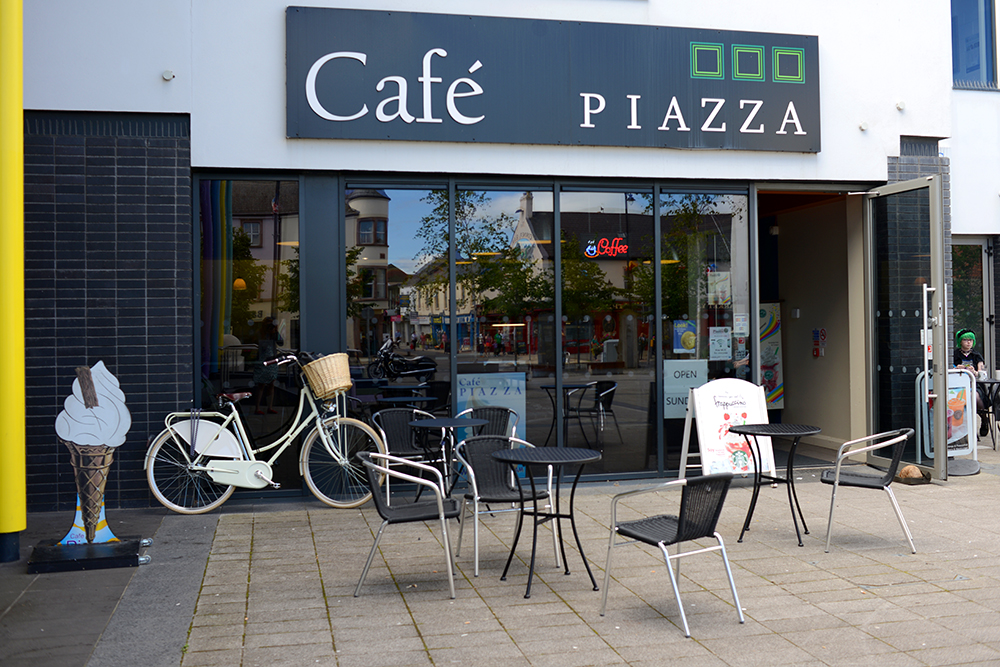
To what do I attribute the Mozie's ease of handling? Honestly, I do not know. I've had a look at the bicycle's geometry chart (which I've been asked to keep confidential) and cannot find anything unusual about it. High trail, relaxed angles, long chainstays, low bottom bracket. Give and take a couple of millimeters here and a couple of degrees there, it is typical Dutch bike geometry, with the exception of the low bottom bracket. I suppose that sometimes a combination of llittle things - whether deliberately or accidentally - can make a difference. And of course, the tubing - described simply as "steel" - can be a contributing factor as well. Whatever Mozie did to make the massive Carolina so light-handling, from conversations with them I get the feeling they might themselves not know exactly. Nonetheless, they realise from both mine and their first customers' feedback, that they might just have gotten it right.
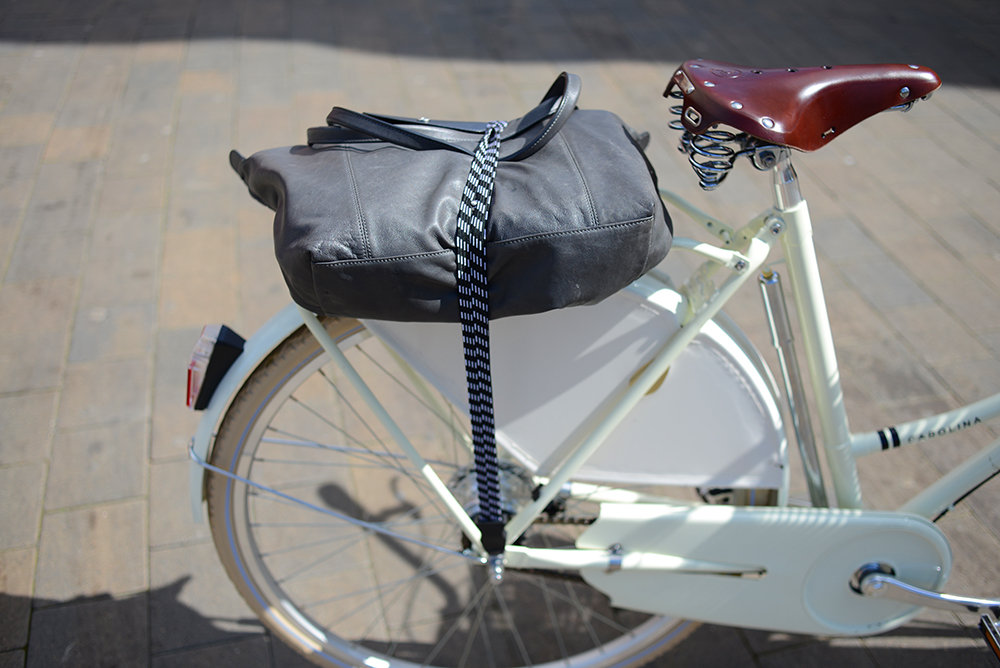
Impressed as I am with the Mozie's handling, the demo version I test rode was not beyond criticism. The tail light is battery operated and not integrated with the dynamo system, which is a shame. And the straps provided for the rear rack were mainly decorative, as I discovered when my bag flew off into the hedges whilst I was in motion! The clips used to secure the dress guards would sometimes slip down when going over bumps, leaving the dressguards loose to go into the spokes.
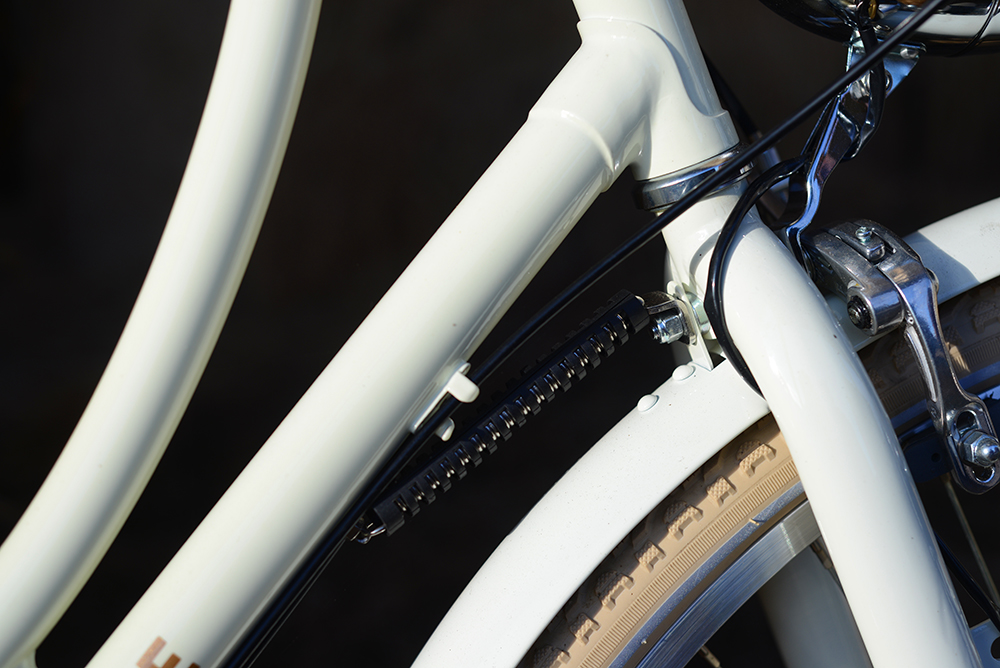
The halogen headlight was very weak and had no stand light - a no-no for traveling on unlit roads. The front wheel stabiliser was of the cheaper variety that did not really "work" as such. And the unicrown fork (sorry, but I can't help myself)... While there is nothing wrong with it technically, to my eye it looks out of place on a frameset that is otherwise so deliberately and beautifully lugged.
To be fair, Mozie tells me that my accessory-related complaints either can be, or might already have been addressed. And a special edition of the Carolina with a brazed fork crown could be available for anyone interested.
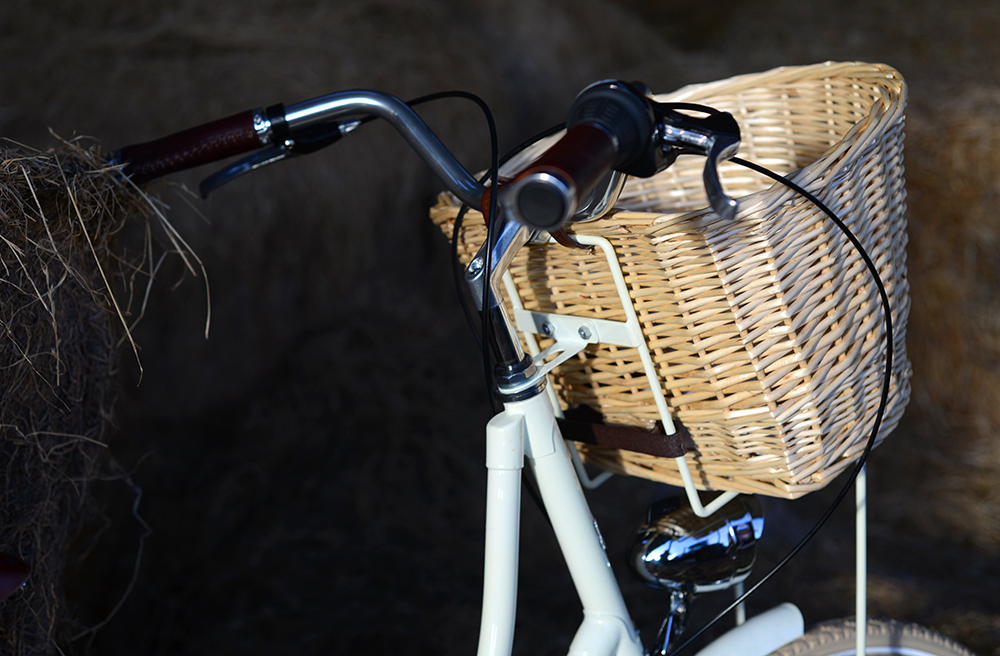
On another positive note, the Carolina's front basket is well thought out, rather than being an afterthought, and comes with its own front rack - attached, decalleur-style, to the headset. This setup is very stable. The basket stays firmly in place, and even with a heavy load of groceries the handling is absolutely fine.
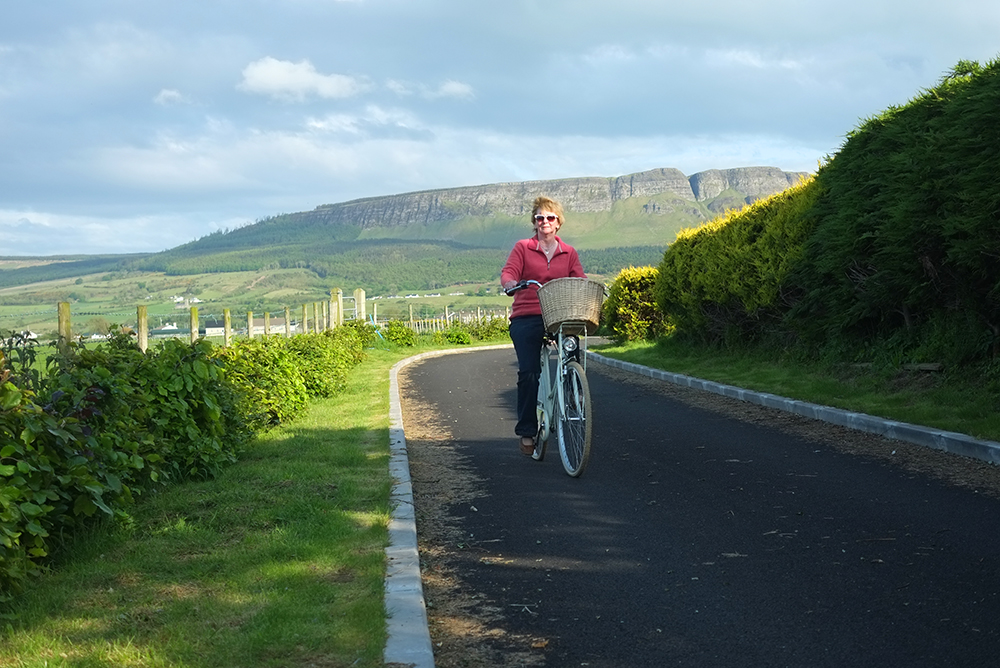
After testing the Mozie Carolina for a couple of months, I gave it away to a neighbour in need of a bicycle. This neighbour - whom I shall call Lady M. - had been wishing for a bicycle to take her on short trips to the nearby shops, as well as to visit friends and family some miles down the road. She is now very pleased with her exotically Californian bike, and makes frequent use of the basket.
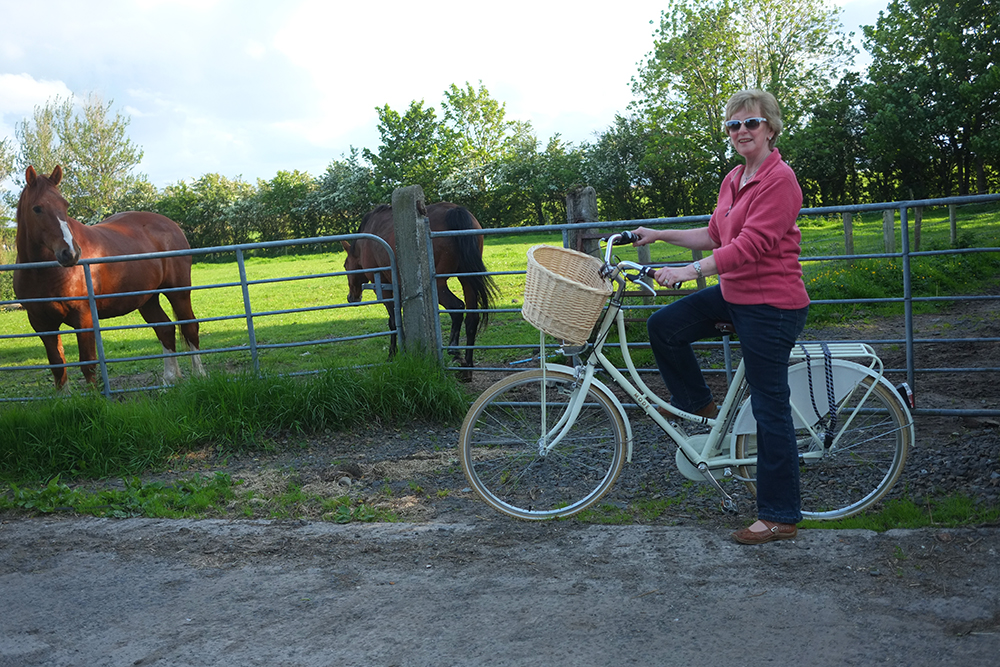
Having used the Mozie through the winter, storing it either in her open garage or outdoors in the course of that time, Lady M. additionally reports that the bicycle is quite durable and weather resistant, requiring little maintenance despite the rainy, muddy, saltwatery conditions we live in. Having looked at the bike after a winter's use, I can confirm this - there is hardly any rust and the machine remains in great condition.
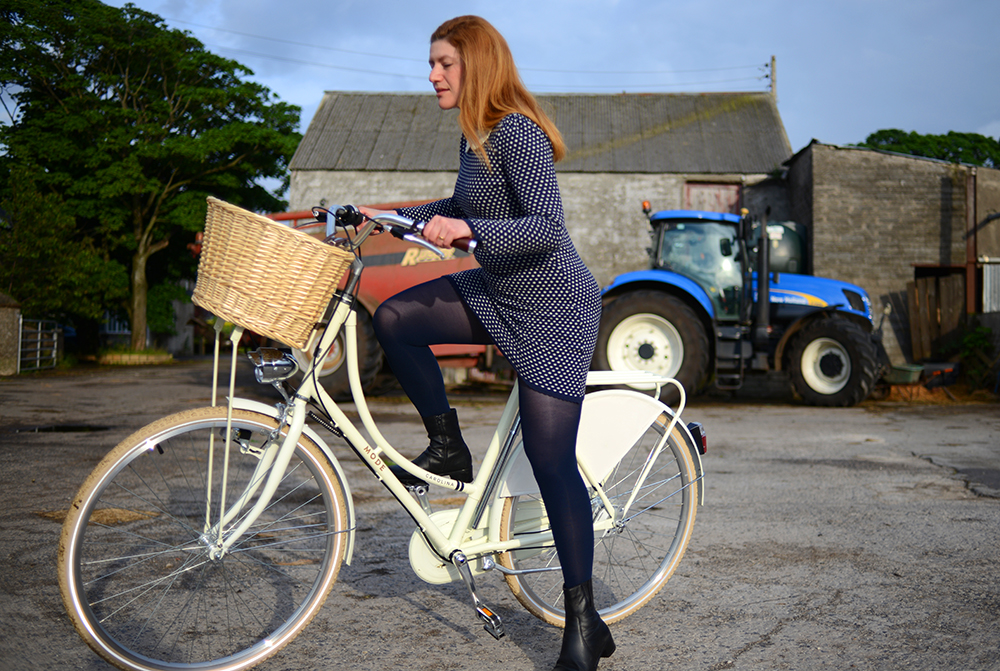
The Mozie Carolina is an intriguing addition to the post-Dutch bike craze transport bike scene in North America. It would make a fantastic bicycle for someone who loves the idea of a Dutch style city bike, but has found the ones they have tried unwieldy. For a bolt-upright bicycle, the Mozie's handling is hard to beat if you ask me, and I only wish their marketing literature stressed that more. There are lots of beautiful, fashionable Dutch-style bicycles around after all, but what makes this one special is how it rides.
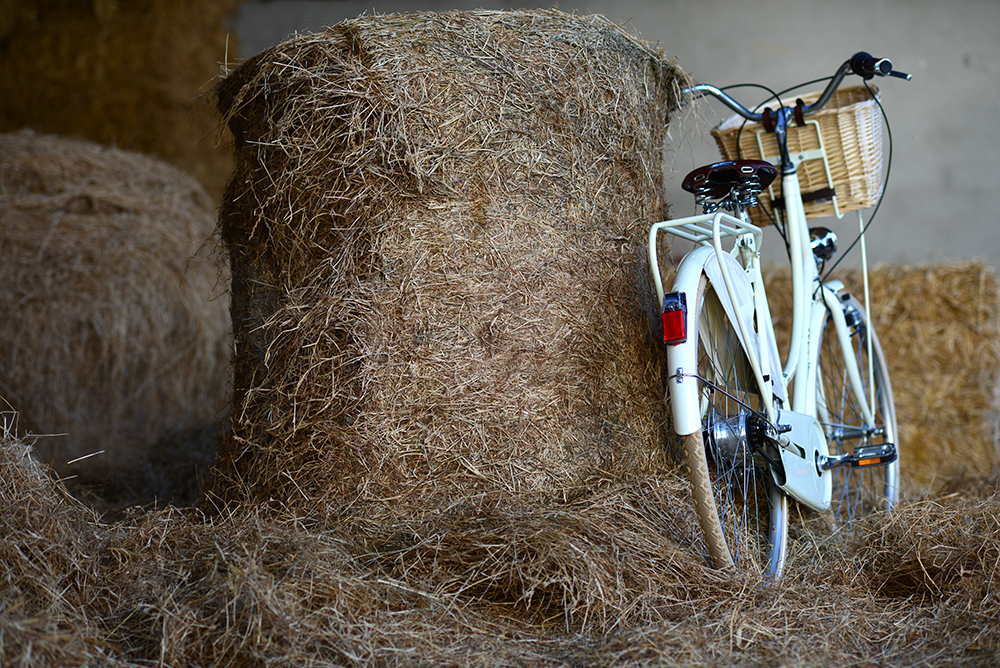
Mozie bicycles are made in China, by a Taiwanese manufacturer with whom the company has a personal relationship, and who specialises in small batch production. The Carolina is available for a sale price of $1,299 at the moment, which some still might consider too high. Admittedly, for a bike in this price bracket it would be nice to get: an LED light with standlight, a dyno-integrated tail light, and better attention to accessory details (i.e. ensuring the straps for the rear rack, the dress guard clips, and the wheel stabiliser are of higher quality). As far as aesthetics, I would also love to see a fork crown matching the rest of the frameset. If Mozie can make that happen (and perhaps get the special edition manufactured by these guys in Detroit to boot?) I might just buy a Carolina for myself.
I thank Mozie for the opportunity to test ride and provide feedback on this bicycle, and for donating their demo bike to a local - who loves it and uses it regularly. Mozie bicycles can be ordered through their website, and are coming to a variety of shops shortly. See here for a full picture set of the Carolina.

Very pretty bike. But for $1300 it would be worth considering if it came with generator hub-powered set of lights and mudflaps. Other than that, it looks great.
ReplyDeleteI'm biased in that I love bottle dynamos (on this style of bike - not on, say, bicycles for randonneuring). The bottle keeps the bike lighter than a front hub, works very well, and is much cheaper than getting a dynohub wheel.
DeleteA set of matching mudflaps on this bike would look great though.
This bike looks like something made for someone with more money than sense. I agree the price is way up there, even at thirteen hundred dollars, but it's the quality of construction and components which seem shocking for that price point. The rear dropouts look like something I'd expect to see on a cheap department store bike, same with the headset and the way the seat stays connect to the seat tube. Is that a Dutch bike thing? I also suspect that anyone purchasing this would have no need for a pump attached to the frame. Clearly, they're not going to repair a flat on the road. Same with the headlight. Anyone buying this is probably not seriously into transportation. At 50 pounds it's an absolute beast if one has to pick it up for even a few steps. Parking it outside seems the only option because of it's size and weight. I can't tell you how many times I've seen folks buy a bike like this only to have it waste away in a garage or have it given away to other unsuspecting, but hopeful, users. The bike craze started here much before 2008 and I think bloggers help to promote ideas and products which really have a short shelve time, mostly because their more about fashion and less about functionality. I don't have an issue with anyone spending their hard earned money any way they seem fit, and some have so freaking much money they can enjoy whatever they want and dispose of it the moment they tire of it, but as one who has lived with bikes for going on forty years and seeing the alternatives for functional, well made, transportation bikes, this one seems a waste. Or it seems like a bike one would date but not live with.
ReplyDeleteDutch/ roadster style bikes are great in the right context. They make sense in many circumstances and I don't agree with your general characterisation of them. But that doesn't mean that it's the right sort of bike for someone, say, in the hilly Seattle - or Boston - suburbs with a 10 mile commute into work. And that was a big part of the problem in the US - people were buying them who needed something quite different to begin with.
DeleteBut I do agree the price is too high for this particular bicycle, considering the quality of some of the components in its current iteration. Would be good to see Mozie adjust that.
Oh, believe me it doesn't have to be hilly Seattle or Boston or even a ten mile commute to dissuade someone of this kind of bike. Even a brief incline in an otherwise flat community can be downright discouraging for a marginal cyclist. So 'the right context' usually means brief, flat, pleasant excursion. Again, I'm only sharing my experience with other women who chose this style of bike (not this particular one) for reasons which ultimately had nothing to do with actually enjoying their attempts daily bicycle riding. I hate seeing potential cyclists wasting time and money on hip or fashionable items.
DeleteI also think buying a bike from a respected local bike shop is important. Usually they carry bikes and brands they support, believe in, and can maintain. The website of this manufacturer shows places one can buy their bikes to more along the lines of boutique and clothing stores! To me, that's a red flag. I always suggest buying a bike from a shop where you know the employees have assembled, rode, and have repaired it over time. Those folks can have wise words to share about the differences between what works and what doesn't. Just my opinion.
DeleteWhen I lived in Vienna, I commuted on a 50lb roadster type bike and it felt like the absolute ideal choice for the conditions there. In Boston, not so much. And it's hard to say why exactly, as the hilliness and distance factors are very similar. My commute into work in Vienna was 5 miles each way. On the weekends I did up to 30 miles/ day in the countryside. For both of those things the bike was awesome; I mean I loved that thing - and preferred it to the aluminum and lighter-weight steel bikes that I'd ridden there as well. I was not alone in preferring to ride that sort of bicycle there either. The city was full of them. And perhaps even more tellingly, several friends of mine who race track and do touring in the Alps (on roadbikes), prefer to use heavy Dutch style bikes as their daily commuters. The lifestyle there and the way the city and immediate outskirts are laid out, it just makes more sense.
DeleteIt is certainly true that some are attracted to Dutch bikes from a fashion standpoint. But then the same can be said of brakeless track bikes. In both cases, however, there are circumstances where that type of bike actually makes sense, even if we personally have not experienced those circumstances.
As for buying from a B&M bike shop: Absolutely. In that sense, cities like Boston are especially lucky, as there are shops dedicated to every kind of riding you can think of.
I'm not speaking of Vienna, where I've never cycled or lived, only here in the four locations I've lived and cycled around the U.S. for transportation. Sounds like your friends in Europe had several bikes to choose from in which case, bless them. If you've got the money and space for multiple bicycles, spend and store and enjoy at will. Sorry, I just care about this stuff and have limited funds, perhaps I'm alone with this, but as I grow older things become simpler. Our landfills and basements are filled with junk. Let's be part of the solution.
DeleteWhen I first re-discovered cycling after a very long haitus, in 2006, I immediately became fixated on Dutch bikes-- they seemed to satisfy all my criteria for a good city bike. I ended up with two Dutch bikes, one newish (2000s), and one vintage (1980s). Both were the real McCoy, Dutch brands, made in Holland for the Holland market. I tried very hard to like them, but after realizing how ill-suited they are to the type of cycling style that I would eventually adopt for city riding (semi-upright, fast), I got rid of both of them. Dutch bikes are only suited for slow riding on flat terrain. They are ideal for hopping on without thinking at all about what you're wearing, and do a great job of keeping you and your clothing clean (full coverage fenders, chaincase, skirt/coat guard, etc). The upright riding position favors those who don't cycle recreationally and don't have (or want) the muscle conditioning for road cycling, and maximizes visibility of the cyclist by motorists, and of traffic by the cyclist-- I did enjoy being able to have a commanding view of everything around me. But ultimately I found them to be cumbersome, and even painful, if ridden farther than a few miles. Even Mrs. Somervillebikes had a genuine Dutchie, a nice vintage 1970s ladies' step-through, loaded to the gills with all the Dutch goodies, but which sadly languished in our basement as her modern Soma Mixte became her preferred city all-rounder. That Dutchie also got sold off recently...
DeleteAnother thing I don't really get concerning Dutch bikes is their weight. I used to believe that the weight was a necessary compromise for the benefit of added durability and cargo capacity, but of course we now know that this is not the case. In my opinion, Dutch bikes are heavy because heavier components and frames are less expensive, and the Dutch don't like to spend a lot of money on their bikes. And in places like Amsterdam and Copenhagen where bike theft rates are very high, it simply doesn't make economic sense to ride around on an expensive bike. So weight becomes the compromise for cost savings. I recently purchased a Bike Friday long-tail cargo bike, and even with heavy duty accessories like a football stadium-sized twin-leg kickstand and front frame-mounted cargo rack, it weighs less than 40 lb-- ten lbs lighter than my former Dutch bike that didn't have nearly the cargo capacity of the Bike Friday. So other than an aesthetic, I really don't "get" Dutch bikes.
DeleteNo reply to my several fountain pen questions, why?
ReplyDeleteAl - you seem to have accidentally posted that comment after the "Taming Trees" post (as opposed to on the post with the pen photo). And I've replied there.
DeleteFrom the review, I like the bike ... I don't mind the price point and I think it looks cute. I commute on a $5000 dollar touring bike and think this would be a nice supplement for when I want to wear a skirt and feel modest.
ReplyDeleteComparing Europe and the U.S. with regard to almost anything seems fruitless. Perhaps this company should focus on selling their bikes in the continent from which they derive their inspiration or the country which manufactures their bikes.
ReplyDeleteThe blog, the photographs, all about happy, a marketer's dream. Yet, the reality often collides with those images. I hope you warn your readers of this simple fact. Choosing bikes is not easy. Filled with challenges and remarkable joys. Choose wisely.
ReplyDeleteIt's interesting you get that impression, considering that I often get criticised for my pictures and posts not being "happy," and for making cycling seem difficult.
DeleteBut in the end, I think we love bicycles precisely because they make us happy. And they simplify life.
Ah the dutch bikes, I so wanted one, but now, no way, never! I had a dutch style bike shape object with derailleurs and wide gearing so I could at least manage hills, but was aluminum and it was a struggle, such a struggle. Hills, mountains, winds, long distances! I would not commute on anything but a road bike and cringe when I see people trying to ride on slow moving bikes, bolt upright against strong winds. My vintage raleigh is heavy enough, but it does have a certain ride quality and really moves once I get it going. It works for the wet rainy winter weather. It is interesting that this Mozie handles so well, and is something that should be promoted more. and yes in the right context a dutch bike is lovely.
ReplyDeleteWhoops, I just noticed your reply -- I'll go to the "Taming Trees"
ReplyDeleteThanks
I love your photos however this type of bikes aren't really my think i would rather bought something practical rather than fashionable
ReplyDeleteIt's a fine looking machine. My only criticisms (aside from your already noted comment about the unicrown fork); are the odd choice of a bottle dynamo, hub dynamo is a must have; and the lights, B&M make superb retro style LED lights, including a fine rear fender candidate, that would enable safe night time riding. It would also benefit from a fully enclosed chain guard.
ReplyDeleteFunny how people say "Dutch bikes" handle badly in high winds. Holland has to be one of the windiest places on earth! When I lived in Amsterdam I had an upright Gazelle which weighed a ton and I never felt it was a struggle. Not because it was mainly flat, but because as a cyclist I was well accommodated with cycle paths separate from cars.
ReplyDeleteNow that I live in London, (still Europe last I checked, but not continental) I have a very heavy Dutch bike that I ride 20 miles round trip to work daily through the city streets. It’s the horrible traffic without space for cycling that makes riding this kind of bike more difficult, not wind, not hills. (Not that the wind is fun, but its manageable.) I suspect it's even worse in America. I sweat much more not out of effort, but out of anxiety (as a London cycle blogger pointed this out here.
I kind of agree with the above anon commenter that most riders will get very little use of this kind of bicycle if the situation is not right. Even though this is a positive review, I am also left with the feeling that it is a bit of landfill, and much cheaper options are available for the same quality (like the British Dawes "dutchess/countess" range).
That's right - I've almost forgotten about the "anxiety sweat." My god. Used to happen to me for the first couple of years cycling in Boston, then stopped.
DeleteI have not tried the Dawes Dutchess, but know a few people who've owned them in London and their feedback was not great.
Didn't mean to suggest that the Mozie bike is "landfill." There are a few issues with some of the accessories. And the price is too high. But as far as handling and ride quality, it is one of the better city bikes I've tried. Now - whether Mozie will be able to sell these bikes given their current marketing model, is another matter. As another commenter has pointed out, their website stresses fashion, which kind of undermines the very thing that makes their product stand out among similar-looking bikes.
The article about cycling in Amsterdam was very interesting - and the idea that cyclists are not required to keep up with motorised transport but rather the city simply accommodates cyclists of all variety. In this situation it is possible to understand how these Dutch style bikes are quite satisfactory as a means of transport - it does give you another perspective.
DeleteI personally would not have a Dutch style bike - I had one many years ago for as short a time as it took me to dispose of it after realising how inappropriate it was for any degree of real cycling, as opposed to just perambulating around the shopping centre - and even that was hard work. In my inexpert opinion these bikes are tractors and I practically shudder whenever I see one as it brings back most unpleasant memories. However, we are all different and there are certainly a few of these bikes in my area - but they are not used by transport cyclists who rely on a bicycle for transport - they are, I believe a novelty bike - at the same time I am aware these types of bikes are popular in many countries as transport bikes. I also do not consider them to be particularly attractive but beauty is in the eye of the beholder. As for the cost, very expensive when a decent hybrid bike which is faster, more efficient (and I think better looking), can be purchased at less than half that price - still, if someone likes that style and is prepared to part with that amount of money, I just hope they are happy with their purchase and enjoy their cycling.
ReplyDeleteMy wife's only bike is a dutch styled model sold by bikesdirect.com, it was very, very inexpensive (less than $400, I think), it is not very heavy, and she loves it, finding it very comfortable and easy to ride. We live in Cambridge, where it's pretty flat, but we've ridden out to Walden pond several times and had no trouble. My only issue with it is that it doesn't fit onto a trunk-mount bike rack very easily!
DeleteAny issues at all with pedal strike? I recently had to replace a favorite frame with something different (a tragic and heartbreaking tale, but one better left for another time), which has a lower bottom bracket. I tend to pedal through turns, rather than coast, and I've been trying to adapt to an annoying uptick in whacking-the-pedals-on-the-path incidents. Good thing MKS RMX pedals are pretty much indestructible (and ugly enough to start with that damage isn't obvious). I keep losing the nickels, though...
ReplyDeleteI don't pedal through turns, so have not experienced it. If you have issues with pedal strike and like to do crazy corner leans, I would not recommend this bike. Plenty of high BB bikes out there. Oh and I think MKS RMX pedals are nice looking!
DeleteC'mon, admit it -- that's the Edge from U2 in pic #14.
ReplyDeleteThe gentleman in the photo notes that he's a "good few" (okay, 4) years younger. And a great deal sexier.
DeleteIt's pretty but at nearly 50 lbs if your commute includes public transit, it is a no-go. Can't imagine lugging that thing up Bart. I've a '97 Trek step through that weighs 29 lbs with comfortable geometry and it is about the max weight one would want for commuting by train/bus/rail. And for $1300 you can do a lot better (thin Linus or Public).
ReplyDeleteYup. If your commute involves any serious bike lifting, this is not the one for you.
DeleteHow about any marginal bike lifting? People forget, when they're no longer driving a car with that big engine under the hood and easy access to power, that moving this machine is all up to you. Starting and stoping on an incline, lifting it over a curb or up a few steps, or even into a sweet parking spot at the bike rack, requires your strength. Large bikes have issues which need to be made apparent to anyone considering using them for transportation.
DeleteAll of that feels fine to me, on this bike and those I've owned myself in the same weight category.
DeleteBut you eventually got rid of all those (upright) bikes in that weight category in favor of much lighter and sportier bikes. Even the Brompton - as you call it your cargo bike - capable of hauling a lot, is lighter.
DeletePerhaps this kind of bike would work in the winter, for short trips.
Really like your blog, but surprised to read that you still promote this type of bike - you've praised the Soma mixte, and Riv mixte before, and those types of bikes make much more sense for many - not as light or aero as a road bike of course, but not as upright and heavy as the type of bike reviewed here. So something like those, but maybe produced cheaper (aluminum, etc), for the general population that can't/won't spend too much on a bike.
The Brompton's hypothetical weight is 27lb unloaded. In practice, mine is more like 40lb on an average day. On days when I really use it as a cargo bike it easily becomes over 50lb. In that fully unfurled and loaded state I routinely carry it over curbs, onto trains, up stairs, etc - because honestly, that's just easier than taking the overloaded basket off and folding the bike, then carrying 2 awkwardly shaped objects separately. My experience of the Brompton's carry-weight then, is really not that different from bicycles such as the Raleigh DL1 (45lb; which I still own), Gazelle (45lb) and Pashley (50lb).
DeleteThe Soma and Rivendell mixtes are wonderful bikes. It nonetheless doesn’t follow that they’re the best bikes to get for absolutely everyone and that Dutch bikes are no good because these other bikes exist. Consider, for instance that the person whose Soma mixte I test rode for my review would later go on to buy a heavy vintage Raleigh 3-speed, which she seems to like at least as much as the mixte. There are benefits to the mixtes over the Dutch bikes, as well as vice-versa. It’s about finding the right bike for an individual’s use case scenario (which may or may not change over the years!). And in that sense it’s great that different options are available.
The problem with aluminum bicycles is that people - in particular new riders - tend to find them uncomfortable. The ride quality over bumpy roads, or - god forbid - cobblestones, can be downright painful. The only aluminum city bike I’ve tried that seems to have solved this problem is the Urbana (reviewed here: http://bit.ly/1IToweK ) - albeit by means of using monstrous tires and a beefed up frame that cancelled out much of the weight-savings. I actually liked that bike quite a lot and reviewed it positively. Funny enough, its “ugliness” seemed to be an issue for many. Can’t win.
That's 27 lb before adding cargo weight, not 50 lb plus stuff. Anyway, Somervillian covered this above, so won't repeat.
DeleteAlso agree with above - Europe and America=different, and this is a Californian company, so Europeans are probably not the target customers.
Owning a bike and regularly riding it beyond a couple of miles here and there occasionally are different things.
Not a fan of aluminum, but that's what many people ride (ie hybrids).
Not everyone needs or will ride a 15lb road bike with handlebars xcm below saddle, but there is something to be said with respect to reasonable bike weight and positioning for efficiency.
Maybe the Mozie somehow works - if I had the opportunity to ride one, I would - but I think this is the wrong direction for a transportation/utility/all around type bike - there are better solutions to strive for.
Well, to begin with the starting weight of a bike vs the loaded weight is something to consider. Starting a 27 lbs vs 50 lbs is quite a difference. A fifty pound bike carrying a small amount of cargo can quickly become closer to seventy. But it's not only that, it's the size of the bike if one has to maneuver it up and down or through doorways, etc. I may not be remembering correctly, but it seems you also complained a bit about weight and size of your Pashley and Raleigh when they were used a primary transportation bikes.
DeleteAs for your Soma friend the vintage Raleigh is quoted a bit smaller than a Dutch bike and while heavier than the Soma it's not up with there with the Mozie. It's also unknown what she paid for it and I gather it's a 'second' bike as opposed to a primary bike -- it has specific purposes, including its cool look, and probably did not coast fifteen hundred dollars!! My issue with the the Mozie is the price for the quality. I think it's aiming at a very small niche market and, sadly, that market includes the uninitiated with regard to what kind of bike might be best for them as they transition into cycling. I want folks to engage in and enjoy what cycling offers, where ever you are and whoever you are and feel that many bikes on the market are made by and for people who really don't cycle. If one wants to own and use a dozen bikes for very specific reasons, bless them, they're probably no stranger to bikes to begin with…and are aware of their strengths and limitations. I've too many stories of (women especially) being sold or choosing a bike which in their mind would be lovely to ride or be seen in (one was purchased specifically because of it's beautiful wicker front basket) and after a few attempts ditching the whole idea. Another missed opportunity for one to fall in love with cycling. Damn.
Aluminum bikes should not be put in one bunch, just like Dutch bikes should not, there are different machines for different uses and different manufactures with different designs. A well thought out bike is the key. Around here aluminum seems to be the material of choice for new riders. Some is price, some is comfort, and no cobblestones to worry about ;)
Totally agree with above. Also, it's one thing to have a heavy vintage bike - precisely because it's vintage, has a certain look, ride quality, and aura. But to manufacture a new bike today that weighs 50 lb and is bolt upright, and is fairly expensive to boot?
DeleteI think that generalizing isn't a good way to decide something. Any category of bike will have poorly designed and built examples in them. What I think is good is if people have some advice on things and know what they're getting and what to look for. It is a shame that it's easiest to buy crap though.
DeleteWhat do you think of roadsters? They're similar to opafiets type frames but still allows you to position yourself as if on a roadbike when wanting to go fast or to sit upright when you want to do that. I'm liking some of the recent bikes that North American companies are designing. European ideas but with North American brakes and parts. (Simcoe, Brooklyn, etc.)
But of course you won't find these at Walmart or Canadian Tire and other department stores so many people won't even know about them.
ok you're still seeing the forest for the trees. Tubing + skinny tires + light wheels. Looking at geo charts is mind candy only.
ReplyDelete*not seeing the forest for the trees. coffee grmblgrmbl
DeleteMm mind candy.
DeleteAlways remember: candy is empty calories.
DeleteIma get my rant on:
ReplyDeleteConfidential geometry?!
That is some pretty pretentious bovine manure from the manufacturer. It's not like they've really invented anything here. Just a nice riding bike - which is great, but hardly ground braking.
Rant off.
Sorry...
In fairness: In my experience of reviewing bicycles, this is actually pretty standard from city/utility bike manufacturers and not at all Mozie-specific. I have seen Brompton's geo specs but cannot post them verbatim either.
DeleteThe "secrecy" is of course pointless, as anyone with enough motivation, a ruler and a protractor can get all the measurements they need to make their own fairly accurate geo chart. So... well, I'm not sure what the reasoning is exactly. But it's certainly within a manufacturer's right to not make the info public and it does't especially bother me.
More interesting to me is the fact that some manufacturers, when asked for the geo info, will not know it - to the point of not even knowing what I mean by "geometry," other than the bicycle's size. They will then ask me to wait, and several days later forward a document which comes straight from the factory. This is very telling of the way many bicycles on the market today are "designed," and also explains why some manufacturers go out of their way to specify that their frames were designed in-house.
Hmm.
DeleteI have always thought it strange when geometry wasn't a part of the specs when looking at bikes.
That the manufacturer didn't know should not be a surprise, but... damn.
Most bicycles are apparently not thought over, but just.. I don't know.. made.
Without any thought past "It might sell".
Same goes for components.
It is a strange state of affairs. One one hand, cheap bikes are far better - and cheaper - than 40 years ago. On the other hand there are very very few bikes that anyone has bothered to think through. Apart, of course from boutique handmade stuff.
We need good stuff for the people.
Ranting again, it seems :-)
this bike looks great, although Velouria could probably make something pulled out of a skip look good, and these kind of bikes are so practical - I had a big heavy sit up and beg that was pretty ancient (as I was quite poor at the time) when I got it and it never broke or even got a puncture and could carry a ton of stuff without even feeling it - it never did more than 10 miles and you wouldn't win the Tour de France on it but I still have fond memories of it. don't agree with the 'more money than sense fashion accessory' assessment of these bikes even though this one does look quite cool
ReplyDeleteThe Leisurist said: Now that I live in London, [...] It’s the horrible traffic without space for cycling that makes riding this kind of bike more difficult [...] I suspect it's even worse in America.
ReplyDeleteIn fact, I daresay most American cities are less congested than London and considerably easier on the cyclist. Certainly those in the western part of the country have wide roads shared among fewer users. Here in southwestern Albuquerque, New Mexico, particularly on the newer Westside (of the Rio Grande, which bisects the city), the cycling infrastructure, and the tolerance of motorists for cyclists, is quite good. Even Washington, DC 30 years ago was not intolerable for an experienced urban cyclist.
Mozie: I've heard others exclaim at the surprising nimbleness of their omafietses. Could this have something to do with the very slack seat tube angle, that puts the rider, even sitting bolt upright, sufficiently behind the bottom bracket?
In fairness to Dutch bikes, Gazelle in particular has had for years a line of more lively handling bikes with steeper head tube angles, shorter wheelbases and 7-8 speed internal hubs that work pretty well in hilly, windy places--like Santa Fe, for example. I had one for awhile and found it more than adequate for around town use and loaded commuting. This bike looks more similar to the sporting version of upright Dutch bikes than it does to the more traditional version.
ReplyDeleteDutch bike too heavy? Make it electric-assist. That seems to be the trend around these parts. Though an omafiet is the rule, not ever the exception.
ReplyDelete(Caveat: The electric assist won't exactly make it lighter!)
DeleteNo, especially when the battery dies.
DeleteGetting a lot of flack for praising this bike, but I'll say, there's something about a bomb-proof, utilitarian bicycle that transcends the passing trends. Find a way to improve upon that, as this bike seems to have done, and I think you've got a winner. My question is, where is it assembled? Domestic bikes warrant a steeper price.
ReplyDeleteIf the object of the exercise is to create pinup photos I'd have to agree that is perfect leg extension. If the object is to ride the bike, no.
ReplyDeletePretty much all the trials and travails recounted on this blog correlate perfectly with a high saddle. From purely textual evidence I'd assumed that was the case. Since V has persisted so very long at this endeavour and has even made progress my guess had been a bit of moderation had occurred. The working fitters I know tell me the clients just will not accept anything but very high saddles, the ones who actually ride the bike and come back they try to talk down.
So here we see a leg stretched about as far as it could go without daylight between shoe and pedal. Appears hyperextended even with the pedal at 4 o'clock. Leaving a possible power stroke from 1 o'clock to 3 o'clock. Not a lot to work with. Some few people succeed at pushing the pedal forward over the top of the stroke, it is not easy or common.
A while back V was offered pointers on how to descend. Including photos of how to get one's butt back. Perfectly correct instructions. The way it is done. With a saddle that high it would just be impossible. The saddle would have to be located the far side of the backbone. I'm an old man, well aware of what would happen to me in a fall. I can and do descend at 60mph. If I somehow got stuck with a borrowed bike with a saddle that high and couldn't change it and had to get down a mountain road I would dismount and walk every turn. I'm not about to screw up my courage and steel my nerves and take risks. With a saddle that high I would walk.
The recent accomplishment of riding out of the saddle would have been so much easier with a low saddle. When the fear of teetering in the unknown got strong how reassuring it might have been to return to the safety and security of the saddle. If sitting in the saddle itself is precarious that scheme doesn't work. No wonder you like long standing excursions. It's the best position you've got.
Anyone who's been to the races has seen a racer grab a spare bike with a saddle 2, 3, or 5cm lower than what their own bike has. And it makes remarkably little difference. Races are finished and races are won with low saddles. if the spare bike has a high saddle there's either an instant adjustment or the racer has to abandon. Bikes simply can't be pushed hard with high saddles. They can't be powered and they certainly can't be handled.
There always seems to be an "experienced roadie" in a nearby corner. This roadie has 50 years on proper road bikes. Before that I did 50 mile rides on my 3spd. The only person ever to adjust my saddle was Jimmy Walthour. I moved other rider saddles under his direction. Now we're talking combined experience of 100 years. Jimmy learned from his father Jimmy Sr., who was also an extraordinary rider. And now we are back to the birth of the sport. No further experience exists.
This week an 82 year old friend of mine, a roadie, was hit-and-run. He was hit-and-run while out riding. He was hit-and-run by another roadie. Excuse me if I do not feel simply being a roadie entitles anyone to special status.
I am quite aware the young ladies do not like the old men telling them how to ride. This old man would rather not see V crack her head open. Put the saddle down - a lot - and you might live long enough to ride me off your wheel.
Sir. I am too old and tired to begrudge an old man his concern over my riding position, let alone to be a pinup.
DeleteI can only hope it might bring you some comfort (though somehow I suspect not) to know that Every Bicycle Fitter I've ever encountered has told me my saddle is slightly too low, if finally approaching acceptable range.
I have a Pashley Princess Sovereign and I consider it as my playful, leisurely ride~much as one would consider their vintage convertible car as the perfect choice on a sunny day. I like to think of it as having a purpose~the right tool for the right job if you will. I also like to challenge convention and ride heavy steel bikes, though I do have a go-fast road bike. I've hoisted the Pashley onto my hitch mount bike rack and traveled to new locations to ride back country roads. Riding 20 miles or so on my Pashely on windy days is not an issue if I am motivated to accept that challenge. I live at the foot of the Ozarks so hills are part of the landscape and I like the try to chug up the hills on the loop frame bike. Is the Mozie aesthetically pleasing? Yes! Is it practical? It depends on your mind set. I think this bike can give the rider a nice ride and a break from the feel for the need of a hammer fest on a go fast type bike.
ReplyDeleteWhy not a bike that's in between - good for utility and carefree riding, but not so heavy or upright. Because riding a heavy bike will be anything but leisurely.
DeleteI have a lighter bike with more appropriate gearing to be sure but it doesn't present the same challenges as the Pashley on the hilly terrain. : )
DeleteRiding a heavy bike with good bearings on level ground is one of the most leisurely things in the world. Once the initial effort to get moving is spent you have a momentum that allows you to glide along in a way that a lighter bike does not allow.
DeleteI paid much less for my upright 2014 Giant Via 2W 7 spd in red. A gorgeous bike in cro-mo steel, with a partial chain guard and fenders. I added a Soma headlight with built-in reflector. I did opt for a softer saddle and lowered the handlebars, as we have a lot of hills. It rides nice for the type of bike it is, without front wobble. The bike weighs in the low 30s. I prefer derailleur bikes to internal hubs here as we don't get snow. I do have other bikes that take hills better.
ReplyDeleteInteresting bike, overall. Who cares if it's heavy if it rides so well?
ReplyDeleteI am wondering about the price point and how they might get it down a little bit. The criticisms of fork, components etc seem well founded from here. I agree with V's point about the integrated lighting.
Also, is it for certain that the Detroit folks will be making a limited-run of deluxe bikes to this pattern?I wonder what their features and price point will be, as well.
I find all of this to be so Ironic. Having lived all over the world, I saw more than not 70 year old Irish men on old rusty heavy no gear bikes going up hills, smoking a pipe, not breaking stride or even a sweat. I saw people in Asia with old heavy rusty bikes, loaded to the gills with cargo 6 foot high pedaling without a care in the world. The Netherlands lets not even go there, the people ride their heavy dutch bikes, cargo bikes with 3 and 4 kids on it, with groceries to boot, while holding an umbrella or reading a book as if they were lounging in a chair. Now why is that? It all boils down to "Just Ride". We're so caught up in weight, this that and the other that we forget to just ride and enjoy it. I own a Pashley, and I go up and down hills with no problems. I ride everyday, I feel which muscles my bike uses the most and in time with everyday riding my body gets in tune with the bicycle. I've been reading your blogs and saw where you had a Pash, sold it, got a raleigh and said that was the bike for you, only to give it up and get a gazelle and sing the praises out of it and give it up. Lol A bicycle is going to perform the way you want it to perform and some bicycles take a little time to build up to it and in that time you learn to love it and develop an affinity with it. Don't forget to just enjoy the ride and forget about all the nonsense such as geometry, angles, weight, chain case etc etc
ReplyDeleteNever gave up the Raleigh DL1. The old Gazelle did move on, as it was intended to from the start. I own multiple bikes and some I get just to try them. Because, you know - I write about bicycles.
DeleteAs for old Irish men smoking pipes going uphill. Indeed, How could they! Enjoy your weekend, hopefully on two wheels.
I've been stalking this bike for awhile. It has every feature I've wanted, but I had discounted it due to the price. You might all be interested (or thrilled!) to know that it's on MyHabit (Amazon flash sale site) for $686. All other Mozie models are there as well. At that price I figure, if I don't like the ride I can resell and maybe even make a little on it. Just had to share my excitement!
ReplyDelete